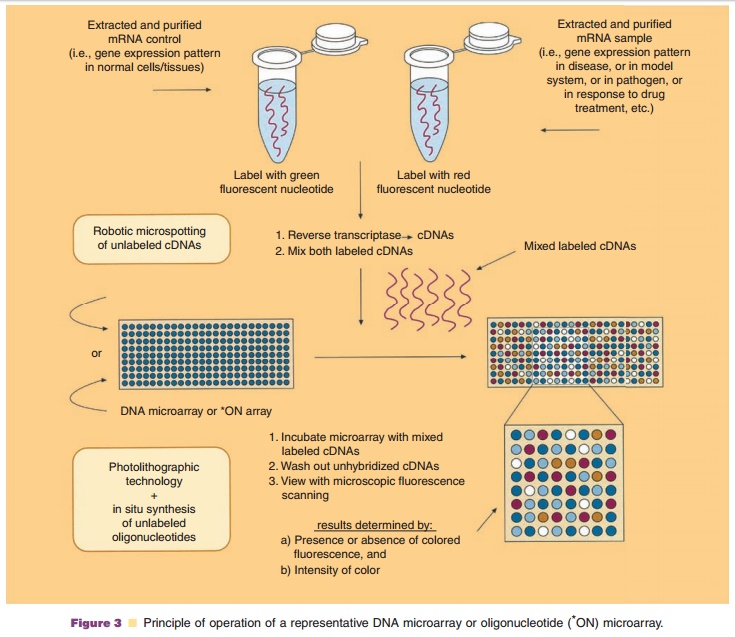Chapter: Pharmaceutical Biotechnology: Fundamentals and Applications : Genomics, Other “Omics” Technologies, Personalized Medicine, and Additional Biotechnology Related Techniques
“Omics” Enabling Technology: Microarrays
“Omics” Enabling Technology: Microarrays
The biochips known as DNA microarrays and oligonucleotide microarrays
are a surface collection of hundreds to thousands of immobilized DNA sequences
or oligo-nucleotides in a grid created with specialized equipment that can be
simultaneously examined to conduct expression analysis (Khan et al., 1999;
Southern, 2001; Amaratunga et al., 2007). Biochips may contain representatives
of a particular set of gene sequences (i.e., sequences coding for all human
cytochrome P450 isozymes) or may contain sequences representing all genes of an
organism. They can produce massive amounts of genetic information (Butte, 2002;
Vaince et al., 2006). While the in vitro diagnostics market has been difficult
to enter, Roche Diagnostics AmpliChip CYP 450 is a FDA-approved diagnostic tool
able to determine a patient’s genotype with respect to two genes that govern
drug metabo-lism. This information obtained may be useful by a physician to
select the appropriate drug and/or dosage for a given patient in the areas of cardiovas-cular
disease, high blood pressure, depression, and others (according to the
company).
Commonly, arrays are prepared on non-porous supports such as glass
microscope slides. DNA microarrays generally contain high-density micro-spotted
cDNA sequences approximately 1 Kb in length representing thousands of genes.
The field was advanced significantly when technology was developed to
synthesize closely spaced oligo-nucleo-tides on glass wafers using
semiconductory industry photolithographic masking techniques (Fig. 3).
Oligonucleotide microarrays (often called oligonu-cleotide arrays or DNA chips)
contain closely spaced synthetic gene-specific oligonucleotides representing
thousands of gene sequences. Microarrays can pro-vide expression analysis for
mRNAs. Screening of DNA variation is also possible. Thus, biochips can provide
polymorphism detection and genotyping as well as hybridization-based expression
monitoring.

Microarray analysis has gained increasing sig-nificance as a direct
result of the genome sequencing studies. Array technology is a logical tool for
studying functional genomics since the results obtained may link function to
expression. Microarray technology’s poten-tial to study key areas of molecular
medicine and drug discovery is unlimited at this stage of development. For
example, gene expression levels of thousands of mRNA species may be studied
simultaneously in normal versus cancer cells, each incubated with potential
anticancer drug candidates. Related microarray tech-nologies include protein
microarrays, tissue micro-arrays, cell microarrays (also called transfection
microarrays), chemical compound microarrays, and antibody microarrays. The
principles are he same, while the immobilized collections differ accordingly.
Related Topics